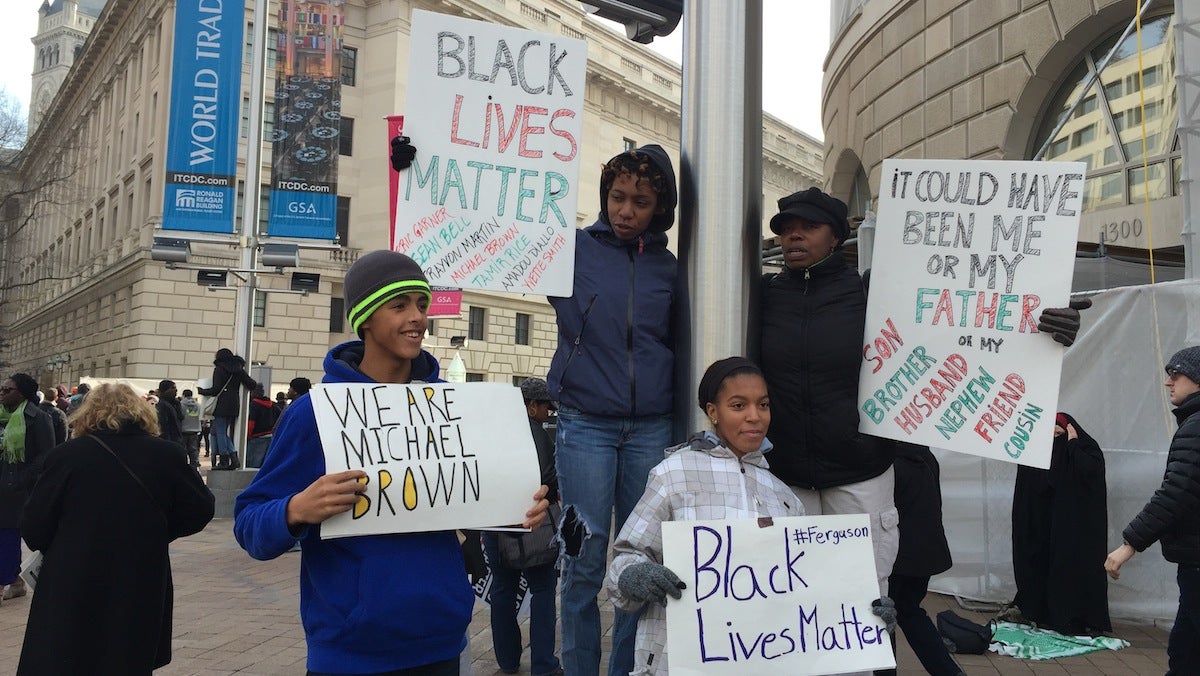‘Justice For All March’ from the eyes of two Philadelphia teenagers

Sam Gerlach and Melanie Graves, sophomores at Springside Chestnut Hill Academy, are the two teenagers shown in the bottom of this picture. (Courtesy of Jennifer Bradley)
The following is a commentary from Sam Gerlach and Melanie Graves, sophomores at Springside Chestnut Hill Academy who attended Saturday’s “Justice For All March” in Washington, D.C.
How long will America tolerate this? How long will we tolerate it? These are the questions we asked ourselves on the night of Nov. 24 and then again on Dec. 3. This was the same familiar feeling we had when George Zimmerman was found not guilty for the death of Trayvon Martin. How long were we going to tolerate these feelings? How long were we going to live in disbelief without taking action?
We attended Saturday’s “Justice For All March” in hopes of being inspired to take action in our community, but once we arrived at Freedom Plaza in Washington, D.C., we knew we were a part of something bigger. We loved being in the presence of such a diverse crowd of people of all ages, races, genders, and backgrounds. The most amazing part was the thousands of people who came from all over including Atlanta, Los Angeles, New York and even Ferguson.
Signs of protest
The signs and pictures the protesters carried were very thoughtful. Many carried pictures of Trayvon Martin, Mike Brown, Eric Garner or Tamir Rice. One sign that stood out from the rest, a quote from the late Maya Angelou read, “History, despite its wrenching pain, cannot be unlived, and if faced with courage, need not be lived again.” A call to end injustice once and for all.
The protest signs and united chants at the march Saturday had a power of their own.
“White silence equals white consent.”
“Hands up. Don’t shoot.”
“No justice, no peace. Know justice, know peace.”
“I can’t breathe.”
“Let the fight for justice continue.”
“When does life become criminal?”
These words reflected the voices of people 50 years ago during the Civil Rights movement, and they dominated the voices of thousands on Saturday. People have been screaming for change for decades.
When the march down Pennsylvania Avenue ended, everyone gathered around the stage and heard the great minds of Rev. Richardson, Joshua Williams, Cornell Brooks, Rev. Al Sharpton and Pamela J. Meanes. Yet those leaders who thousands looked up to on Saturday were not there simply to be heard, they were there because they know they have the power to encourage us all to create change together.
Powerful speakers
Everyone present was an inspiration to those around them, a shoulder to cry on, and a person who dreamed of a justice that is long overdue. Although we heard the voices of the families whose husbands, sons, brothers and fathers died at the hands of police brutality, and although you could sense the crowd’s anger and frustration, there was not a single soul seeking revenge.
One standout speaker was most definitely Pamela J. Meanes, the president of the National Bar Association.
She was a passionate speaker who inspired the crowd and directly addressed the problems with policing today.
The focus of this march was making it known that police brutality and racial profiling were closely linked and that the nation is calling for federal intervention in local cases. With our knowledge of the injustice that occurs across America everyday, Attorney Ben Crump promised that, “We will stand up for our children in every courtroom in America.”
We couldn’t agree more. We will not fall silent, we will not cease to protest and we will not go unheard.
Leighton Watson, the student body president of Howard University said, “Racism is as American as apple pie,” and once again, we couldn’t agree more.
As each new person took the microphone and offered their insight on the issues, valid points were made. However, there was one overriding theme theme: Black lives matter. All lives matter. And it is unacceptable for any one of us to continue to live as if this is untrue.
Final reflections
Melanie: I was quiet; I observed every little bit and piece of history in my presence. I wanted to be able to remember every moment unfolding before me. I was there for something bigger than myself, I was there because I knew that this was a movement that would not go unheard, and I was there because I believe in the power of voices in numbers that cannot be ignored. I believe that America is through with tolerating the injustice that the oppressed have endured throughout this country’s history. America is through with sitting at the table of injustice. America is demanding change.
Sam: When I look back at the more important events that I, as a young black male have attended, I look back on experiences from President Obama’s first inauguration to teaching in a school in Yetebon, Ethiopia.
Still, this march on Dec. 13, 2014 was one of the best days of my life. Not only did I get to see how strong the families of Trayvon Martin, Michael Brown, Tamir Rice, John Crawford III, Amadou Diallo, and many others who didn’t make headlines are, I got to see how united they were. The one chant that was repeated time after time and still stands out from the rest was, “United we stand, divided we fall.”
WHYY is your source for fact-based, in-depth journalism and information. As a nonprofit organization, we rely on financial support from readers like you. Please give today.

